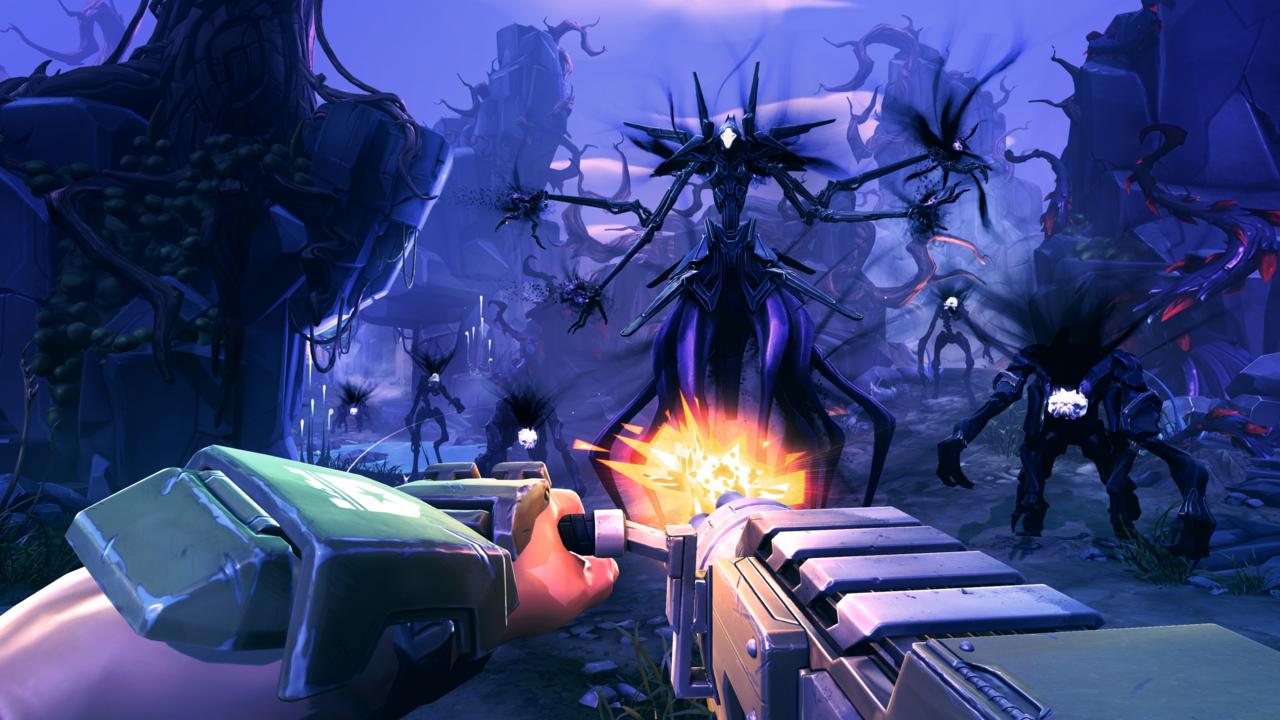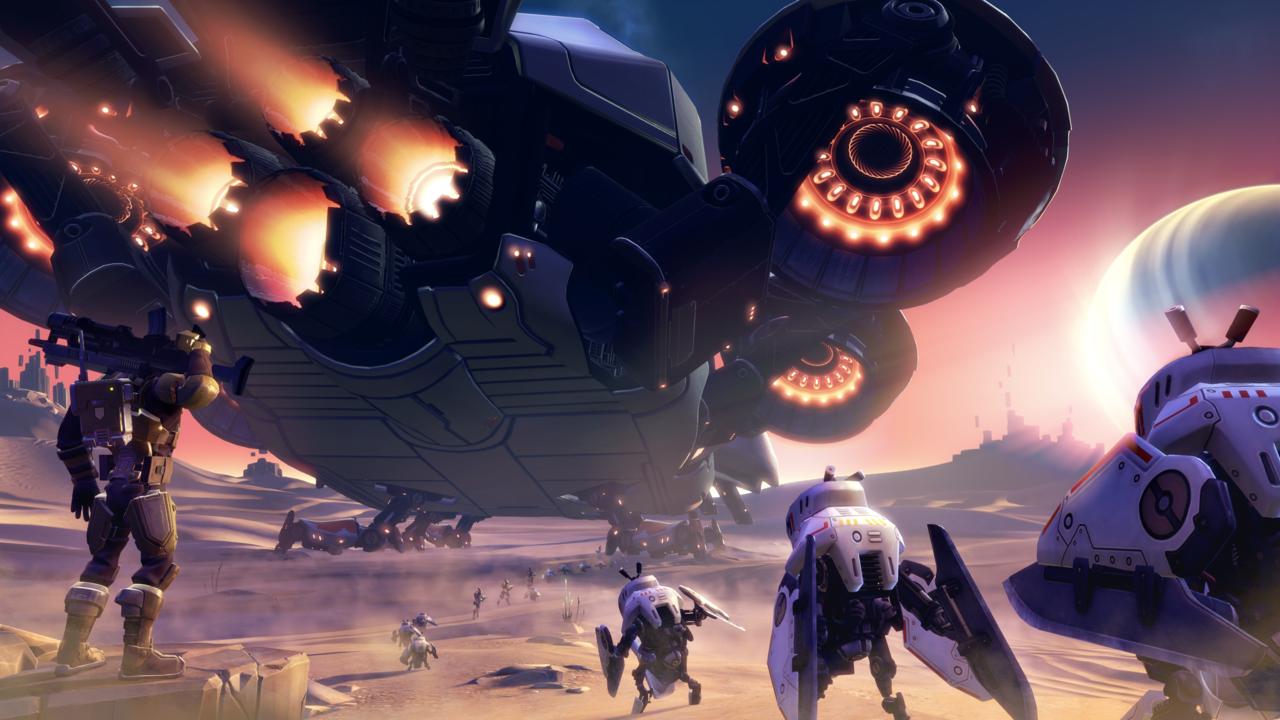Geoff is having a bad day. The giant arachnoid’s disconcertingly upbeat boss won’t stop berating him over the shared comms system, and worse still, a squad of five vastly different heroes has infiltrated his snowy mountain fortress and are currently beating the crap of out him with everything from over-sized swords to cartoony chain-guns to toxic spore clouds. It’s a campaign mission that’s at once familiar and alien. The sardonic banter between Geoff and his boss feels unmistakably Borderlands, as do the cel-shaded art style and many of the game’s underlying combat mechanics. Yet structurally, first-person “hero shooter” Battleborn’s individual missions seem to draw from other, more MOBA-flavored influences.
Unlike Borderlands’ missions, the campaign section I played felt like a series of arenas, which had a subtle but noticeable impact on gameplay momentum. Enemies would flood a particular area, my team and I would wade from the entry to the exit killing everything in our path, then we’d regroup and wait for the next event to trigger or door to open. Along the way, we’d collect currency called shards and purchase turrets, traps, and even friendly flying drones to follow us around.

There were moments when pathfinding became an issue--like when we weren’t clearly notified a nearby trapdoor had opened--but this approach also allowed for a few clever design twists. Take Geoff, for example. Because our mission played out like a progression of discrete but ever-escalating encounters, Geoff was able to repeatedly appear, attack, and retreat only to appear again later in the level with dramatic new upgrades. That sort of multi-stage boss encounter might feel forced or even out of place in other shooters, but here, it just fit. And we did eventually murder Geoff. Sorry, Geoff.
According to the developers, story missions will generally last between 20 and 25 minutes and, interestingly, can be played in almost any order following a prologue mission that establishes the universe and introduces players to Battleborn’s fast-paced, team-focused action. “We think of story missions a little more like TV episodes,” Creative Director Randy Varnell told me following my hands-on time with the game. “While there probably is an ideal order for them, every mission has a beginning, middle, and end on its own. We wanted to think of replayability. And also, if you play a linear story, you have a lot of players in those first few missions and then it’s really hard to find co-op buddies [for] those last few missions.”
We think of story missions more like TV episodes. While there probably is an ideal order for them, every mission has a beginning, middle, and end on its own.
Randy Varnell, Creative Director
For those who may not be familiar, Battleborn’s narrative gathers 25 heroes from dying worlds and chronicles their efforts to save the last burning star in their galaxy from the villainous Rendain. And despite the campaign’s disconnected missions, Varnell assured me there is a “final mission that you will unlock after you’ve played a certain amount that will give you the end of this chapter.” You’ll also gradually earn new heroes as you complete missions, which should further imbue the experience with a sense of progression. Geoff’s boss Isaac, for example, becomes playable once you complete that particular level.
Battleborn’s structure isn’t the only aspect that leans more towards MOBAs than traditional shooters. It’s loot and leveling systems--while again rooted in recognizable Borderlands ideas--focus more on short-term upgrades that reset quickly rather than RPG-style character progression. For example, players can find or purchase “gear packs” using currency collected in-game. These packs are color-coded by rarity, can only be opened between missions, and generally contain one to three pieces of loot, each of which provides a passive upgrade like speed boosts or even cheeky abilities like automatically dropping a live grenade every time you’re forced to respawn.
Here’s the catch, though: you can only equip three of these passive upgrades at a time, and not only must you pre-select them before joining a mission, you must also activate each upgrade individually using the same collectable in-game currency that buys turrets and drones. At the end of each mission, your abilities deactivate and the cycle restarts, adding a layer of resource management on top of the already frantic gameplay. Do you plow forward into your enemies or duck off to the side to collect some shards? Do you spend those shards on a turret or activate your speed boost? Or do you save all those shards to activate your more powerful but more expensive abilities later on?

Similarly, characters quickly level up over the course of each campaign mission and multiplayer match, but all the progress resets once the round ends. Skilled players could potentially level up 10 times each match, and at each new level, they’ll be able to pick one of two pre-set stat boosts. While the passive perks provided by gear are very general and work for any character, the stat boosts available through the leveling system are unique to each hero. You might be able to double the range of a specific attack or shorten the duration of its cool-down period.
Also unlike gear, leveling allows players to spec their characters while the battle actively rages around them, giving them a chance to react to their opponents’ strategies and change tack on-the-fly. I spent a lot of time nearly dying while trying to read upgrade descriptions during combat, but I imagine once you learn the characters and develop a playstyle, picking your upgrades will probably just take a split-second of muscle memory.
In fact, robust as the loot and leveling systems may be, Battleborn’s massive character roster is what truly defined my hands-on experience. Each character felt not only fully realized but also totally distinct, as if he’d simply been beamed into this game after starring in his own. Metal-clad soldier Oscar Mike, for example, controlled exactly like your standard space marine: use the left trigger to aim down sight, pull the right trigger to fire, hit the bumpers to toss explosives, and so on. Sword-wielding Rath, on the other hand, played more like the star of a melee-focused action game like Metal Gear Rising. There’s also ranged support character Marquis, healer Miko, airborne crowd-controller Benedict, and on and on. Obviously all these characters look extremely different, but it turns out their diversity extends beyond the aesthetics and into the mechanics.

What’s perhaps most unique about Battleborn, however, is just how weak its heroes can feel when you try to use them outside of their intended roles. Plenty of games do their best to incentivize cooperation among teammates, but generally you can still run off on your own and have fun as a lone wolf. Think of basically any team-based shooter: even if you ignore your allies, you’ve got a gun and some ammo and can rack up a healthy kill/death ratio. In Battleborn, working with your teammates not only increases the likelihood your team will win, it also generally means you, as an individual, will be more effective and will therefore have more fun.
For example, muscle-bound Montana looks like an unstoppable tank, but if an enemy can get right up next to him, he’s too slow and unmaneuverable to defend himself. He’s far more useful and successful when he hangs back and provides suppressing fire for faster characters who were actually built for rushing. Likewise, Miko the mushroom-headed healer is perfect just behind the main battle as he can shield and heal melee fighters. And when you use Miko to buff Montana, the two become a serious powerhouse.
In Battleborn, working with your teammates not only increases the likelihood your team will win, it also means you, as an individual, will be more effective and will therefore have more fun.
While it’s important to consider each character’s unique strengths and weaknesses while playing story missions, it’s downright essential when facing off against other human players in one of Battleborn’s three five-on-five competitive multiplayer modes--which include a standard point capture mode, an escort mode where teams score points by guiding minions to a portal, and a third yet-to-be detailed mode. Every character will likely be capable of dominating certain other characters in head-to-head match ups simply because of their clashing roles and abilities, but building a balanced team--and sticking together in game--should help avoid strategic mismatches.
A good example of a balanced fight would be Phoebe versus Orendi. Phoebe is an up close damage dealer and has the ability to quickly close distance with a teleport called Phasegate. Orendi is a hit-and-run attacker who can get in, drop her Shadowfire Pillar, then use Nullify, which drops a blast that propels her away from the action. If they see each other, Orendi wants to bait Phoebe into wasting the Phasegate teleport first. That way she can drop Nullify, do damage, and jump backwards out of Phoebe’s striking range before lighting her up with ranged attacks. If Orendi uses Nullify too early, then Pheobe will just teleport on her and she’s pretty much finished.

This strategic push-and-pull adds an impressive amount of depth to Battleborn’s gameplay, but it also makes balancing the game a daunting prospect. It’s an issue the developers are keenly aware of. “The short answer is, we’re absolutely terrified about balancing this game,” admitted Varnell. “The longer answer is, we’ve been balancing it since the very beginning in some ways. My phrase to my designers is: ‘In this game, balance is not an event, it’s a discipline.’ We know that we’re not going to be perfectly balanced at launch, so we have a pretty broad support plan for continuing to support the game in patches. We’re monitoring it, making changes as fast as we can, and listening to the community.”
It’s a refreshingly forthcoming answer, and fortunately for the team, they have until February 9, 2016 to finetune Battleborn’s outrageously large cast. Until then, we’ll continue to follow the game’s development and assemble a tasteful memorial for Geoff the giant spider monster.

